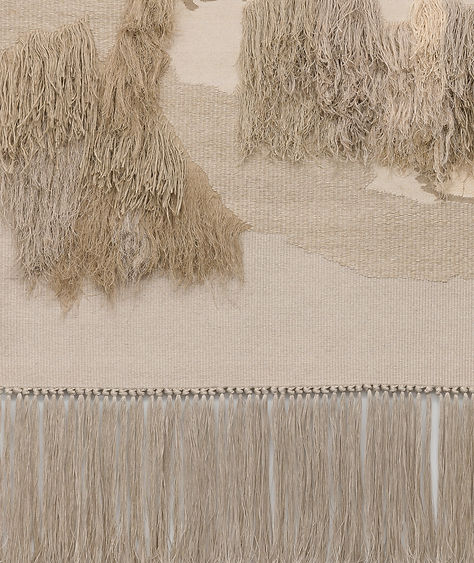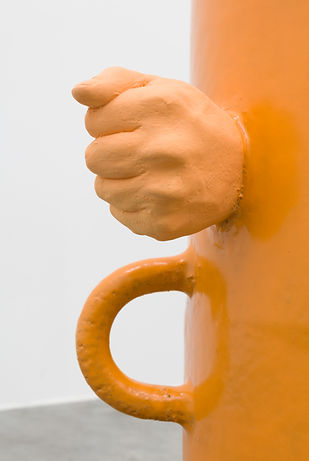ANDREAS ERIKSSON, YINKA SHONIBARE JUSTICE FOR ALL, JONATHAN BALDOCK FACECRIME (suspect)
Akin Oladimeji, July 2020
The passage of time and power of nature, justice, communication. There's a multitude of themes being expressed at the Stephen Friedman gallery in this trio of shows in a turbulent era.

Andreas Eriksson, Pink Semaphore, 2020. Oil and acrylic on canvas, 195 x 240cm (76 3/4 x 94 1/2in). Copyright Andreas Eriksson. Courtesy the artist and Stephen Friedman Gallery, London
Andreas Eriksson’s tapestries are artworks he calls ‘existential landscapes’. Living in a forest in Sweden he gains inspiration from the natural landscape leading the viewer to get a sliver of the visual pleasure of experiencing the outdoors while indoors. An artist whose work was displayed at the Nordic Pavilion at the Venice Biennale in 2011, he aims to evoke landscapes using fibres derived from the country. For this show, five weavers worked at their looms for two years to bring to life his vision of scenery, stitching together his overwhelming interest in nature with his desire to create art focused on the passage of time.
Not all the works in the two rooms that make up this exhibition are tapestries. One of my favourites, Pink Sempahore, is executed with oils and acrylics with washed out colours juxtaposed with brighter shades of pink, blue, orange and jungle green to create a stunning visual effect. Another eye-catching piece Weissensee No. 12 is a tapestry designed in such a way that the vertical threads drop and echo a waterfall. Other works are named similarly in numerical order, which emphasises the importance of the place in Berlin (a neighbourhood with a lake at the centre) where they were woven. The majority, to me, are lifeless and could have done with being sexed up with depictions of animals but maybe that’s the point: these are calm, contemplative celebrations of the natural world. His use of linen, an ancient material, and the fact the work is about the importance of nature echoes the idea of slowness that in this lockdown era is clearer than ever. It is as if it is reminding us we are powerless before the elements and we had better get used to not always being in control.

Andreas Eriksson, Weissensee No. 12, 2018-2019 (Detail). Linen, 240 x 141cm (94 1/2 x 55 1/2in).
Copyright Andreas Eriksson. Courtesy the artist and Stephen Friedman Gallery, London.

Yinka Shonibare CBE, Justice for All, 2019. Fibreglass sculpture, hand-painted with Batik pattern, brass, hand-painted globe and steel baseplate. Sculpture: 232 x 206 x 60cm (91 3/8 x 81 1/8 x 23 5/8in). Installed at Stephen Friedman Gallery, London (2020).
Copyright Yinka Shonibare CBE. Courtesy the artist and Stephen Friedman Gallery, London.
Commissioned by Asian Art Institutum for The Arts House, Singapore (2019).
Two doors down Anglo-Nigerian artist Yinka Shonibare, also represented by the Friedman gallery, has a sculpture of Lady Justice, based on Pomeroy’s version, on display in the gallery’s Viewing Room. The powerful work is called Justice for All. Let me tell you about justice. I remember as a child I saw a book that showed a bobby on the beat in a traditional helmet and the caption: the policeman is your friend. Then as I grew up in Nigeria where bribes were routinely given to police officers, where the agents of social control often killed civilians and blamed it on an ‘accidental discharge’ of their weapons, police brutality was the norm and corrupt politicians were often lauded, I gained a cynical view of the concept. As a man in my twenties I learnt not to walk around with a hoody or do anything that would lead to unjust treatment at the hands of the law knowing that I’m guilty until proven innocent in the eyes of a racist officer.
The violence that has led to the Black Lives Matter movement has meant the word ‘justice’ is now being picked up, shaken and examined from every angle and being interpreted by a number of artists. And so we come to Shonibare whose use of Dutch and Indonesian fabrics used in African traditional clothes to denote the slipperiness of cultural identity is a major trope. It has been derided by some as an embodiment of the idea in a way that’s too easily absorbed. Here it effectively emphasises the fact that justice cuts across cultures while the use of a globe for the statue’s head points to the fact the concept is a worldwide one. The golden sword in one outstretched arm points to retribution for wrongdoers and the scales in the other hand denote equal treatment. Installing the work in a locked room which the audience can only view from the street distances us from it, perhaps reminding us we are far from achieving fairness.

Yinka Shonibare CBE, Justice for All, 2019. Fibreglass sculpture, hand-painted with Batik pattern, brass, hand-painted globe and steel baseplate. Overall: 292 x 206 x 70cm (115 x 81 1/8 x 27 1/2in). Installed at Stephen Friedman Gallery, London (2020).
Copyright Yinka Shonibare CBE. Courtesy the artist and Stephen Friedman Gallery, London.
Commissioned by Asian Art Institutum for The Arts House, Singapore (2019).
Across the street young British artist Jonathan Baldock follows last year’s show of masks with Facecrime (suspect), an installation of columns. Unlike his more expansive show at the Camden Arts Centre in the summer of 2019 combining the masks with similar sculptures and a rug his mother helped him stitch which visitors could walk on, the current exhibition gives a more condensed but still enthralling version of his output.
The title is borrowed from the crime of adopting the wrong expression in Orwell’s 1984 and Baldock mentions in the press release how a lot of his work is to do with the way we communicate non-verbally. You encounter five ceramic columns with parts of the artist’s body – ears, lips, hands which have been cast and protrude from the surfaces. There are also emoticons embedded within the columns which add a humorous touch.
%20II%207-d3.jpg)
%20I%206-d1.jpg)
Jonathan Baldock, Facecrime (suspect), 2020. Ceramic, steel, hand-spun yarn. Dimensions variable. Copyright Jonathan Baldock. Courtesy the artist and Stephen Friedman Gallery, London.
Photo by Mark Blower.
When I asked him about the colours used, he responded:
'The work is in part supposed to evoke a ruin. The ruins of antiquity are often depicted as colourless and dead, when in fact the ancient world was full of colour. I wanted the sculptures to feel full of life and I see colour as one way of doing that. With the installation at Stephen Friedman I chose a palette of blue and orange which I see as having a spiritual quality which hopefully has a direct effect on the viewer.’
Emanating disconcertingly from speakers concealed in the columns are whistles, chuckles and groans underscoring the theme of communication the artist is portraying. The work was arresting and while a more immersive installation like the version of Facecrime currently on display at The Bluecoat, Liverpool with coloured sand flooring might have been even more engaging, there is enough here to encourage multiple visits.
Akin Oladimeji
akiola1.dreamhosters.com
Stephen Friedman Gallery
stephenfriedman.com
Exhibitions open until 31st July

Jonathan Baldock, Facecrime (suspect), 2020. Ceramic, steel, hand-spun yarn. Dimensions variable.
Copyright Jonathan Baldock. Courtesy the artist and Stephen Friedman Gallery, London.
Photo by Mark Blower.
